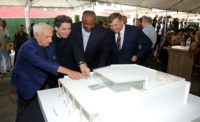Los Angeles Announces Winners to Open Design Low-Rise Challenge

Brooklyn-based Vonn Weisenberger won Corners with his “Branch House” proposal.
Image courtesy City of Los Angeles

In the Fourplex category, the first-place winner was “Hidden Gardens” by the Los Angeles firms Omgivning and Studio-MLA.
Image courtesy City of Los Angeles

In the Subdivision category, first place went to Green Alley Housing.
Image courtesy Louisa Van Leer Architecture



The results are now in from Los Angeles’s $100,000 open design challenge, which asked architects and landscape architects to propose innovative, sustainable models for low-rise, multi-unit housing. The initiative—launched last November by the mayor’s office, along with the city’s chief design officer, Christopher Hawthorne—drew nearly 400 responses worldwide. Funded by the James Irvine Foundation, Los Angeles Department of Water and Power, and Citi, this call-for-ideas aimed to open up productive dialogue, as Hawthorne puts it, “to break the logjam for the future of low-rise living in LA.”
The design brief makes the case that the “American Dream” of private home ownership—having become increasingly the realm of the privileged—“needs an update.” With Los Angeles essentially out of space to extend its sprawl into more single-family subdivisions, Hawthorne writes in the introduction to the challenge, “the standalone house has become more a place to protect wealth than to begin building it.” One severe limitation on further spread has been the danger near the wildland-urban interface, where the incidence of massive wildfires has grown exponentially, threatening inhabited communities. With climate change gaining momentum, the need to build sustainably has clearly become more urgent—prompting the call for greater density and growth closer to the urban core. And low-rise fourplexes have been shown to offer particularly high potential for efficiency—in terms of both affordability and environmental costs, from construction through ongoing operations. As the design brief puts it, “An intelligently designed fourplex may well use the same or less energy and water than a large single-family residence on the same lot.”
But even with more than 80 percent of Los Angeles’s residential land dedicated to low-rise use and about 70 percent of that as single-family houses, there’s often been resistance to anything else. The opposition comes “not just from wealthy, predominantly white homeowners in the hills,” says Hawthorne, pointing to widespread distrust of even modest multi-family development in underserved communities of color, where legitimate concerns persist about gentrification, displacement, loss of neighborhood character and green space, and redlining or other exclusionary and racist lending and zoning practices.
Gaining both trust and enthusiasm for thoughtful change is where architecture could play a key role. While the highly attractive, mid-century-modern Case Study program inspired LA’s still-thriving culture of inventive house design, the multi-family realm has seen relatively little progress in decades. With some notable exceptions, the days are gone when the likes of Irving Gill, Rudolph Schindler, Richard Neutra, and Paul Revere Williams created bungalow courts or other affordable, forward-thinking housing for modest-income residents.
But the goal of this challenge, Hawthorne cautions, “is not to reward innovative form-making or experimental architecture for its own sake.” Instead, he says, it’s a search for design that speaks to the history, climate, diversity, and politics of LA—and explores the future of its low-rise neighborhoods, advancing the broader civic discourse. As he sums it up, “We are most interested in proposals that demonstrate a newfound flexibility in housing options—and make that flexibility attractive and communitarian in spirit—as opposed to simply increasing the number of units.”
To better understand the needs and desires from the grassroots up, the process began with themed “listening” workshops that brought together local residents with members of community land trusts and sustainability groups, among others. That phase preceded the call-for-ideas—and those video-recorded sessions, totaling nearly eight hours, became required viewing for the design-challenge participants, informing their proposals.
There was no entry fee, and contenders were welcome to compete in any, or all, of four categories: Fourplex; Subdivision; (Re)Distribution; and Corners. “Subdivision” (a whimsical play on the word) called for a standalone two-unit structure (or California “duplex”) on a site carved from an existing single-family lot. “(Re)Distribution” challenged participants to, hypothetically, divide an iconic, landmarked, single-family house and/or its site into four units. And “Corners” asked for six to 10 units, plus a creatively reinterpreted “Accessory Retail Unit,” across two adjacent sites, at least one of which occupies a corner. All four types suggest interventions far gentler and less disruptive to neighborhood fabric and equilibrium than more massive multi-unit buildings.
The submissions were all anonymous, and cash prizes ran as high as $10,000 each. The jury included architects, academics, and members of city government, as well as experts in landscape, sustainability, housing, and planning, among other areas.
In the Fourplex category, the first-place winner was “Hidden Gardens” by the Los Angeles firms Omgivning and Studio-MLA. Their proposal suggests a dynamic play between indoor and outdoor conditions, with gardens weaving through the “porous” two-story buildings and in-between spaces. Modulated by specific views and sound-buffering vegetation, the scheme seeks a balance between privacy and communal life. Storm-water gardens, passive shading, screening devices, a deciduous tree canopy, and climate control through solar energy and wind patterns all contribute to the zero-net commitment of this model.
In the Subdivision category, first place went to Green Alley Housing, the name of both the project and the collaborative group that designed it. This proposal turns underused alleys into landscaped, bicycle/pedestrian-friendly walkways, lined with the front doors to standalone, duplex, live-work units. Through propagating these structures on neighboring sites, the scheme could extend out, fostering community and potentially combining adjacent open spaces to form common greens.
The winner of (Re)Distribution, the UK-based Arts and Creatives Designs Ltd., proposed reimagining the Schindler House and its site with four diverse apartments, suited to different needs and lifestyles. The design provides for co-living (or communal kitchen, dining, and living areas, shared by more than one unit); it also integrates natural ventilation, as well as native, drought-tolerant landscaping and opportunities for residents to collect rainwater, produce energy, and grow food on site.
For Corners, the top-prize recipient was Brooklyn-based Vonn Weisenberger. His “Branch House” evokes the laid-back, outdoor-oriented character of California Ranch style and such classic Los Angeles typologies as the bungalow court. It proposes a framework for multiple configurations, depending on the specific site and needs, integrating two-story units of varied sizes. Every two homes share a modular mechanical-and-plumbing core, suitable for economical, off-site prefabrication. The buildings, which could include optional indoor community space, are nestled amid shady, planted patios, with sustainability strategies that include green roofs, water harvesting, permeable surfaces, renewable energy generation and storage, and passive cooling with cross-ventilation.
LA’s Low-Rise challenge is part of a larger research initiative, supported by the James Irvine Foundation and other key partners, with a stated mission “to explore new paths to homeownership and models of affordability in low-rise neighborhoods across Los Angeles.”
Ideas from the winning entries may help inform future housing policy, and, says Hawthorne, the mayor’s office also hopes to work with council offices and affordable-housing groups to plan a second phase for this initiative. No promises yet, but the goal would be to actually build some of the designs.









